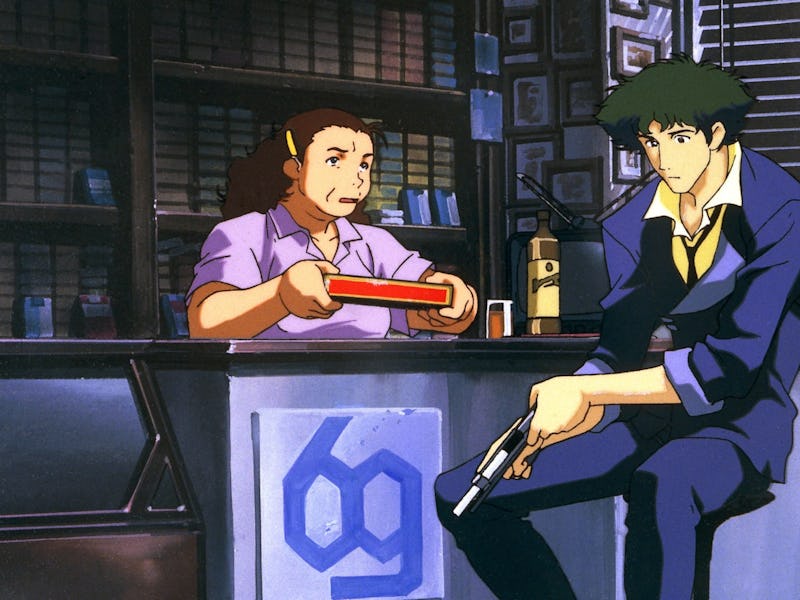20 Years Later, Cowboy Bebop: The Movie Still Plays Out Like A Bittersweet Fever Dream
Both a fitting introduction and a fitting finale, the film takes a leisurely look at the hearts of our heroes.

Shinichirō Watanabe caught lightning in a bottle with his beloved, anachronistic genre-mashup, Cowboy Bebop. Part space opera, part neo-noir Western, Cowboy Bebop introduced a fantastical, dystopian world inhabited by characters who remain unmoored to their realities, yearning for an impossible future while shouldering the weight of the past. But when Watanabe made Cowboy Bebop: The Movie as an extension of his acclaimed series, the meandering 2.5-hour adventure nestled between the events of episodes 22 and 23 was deemed forgettable compared to the timelessness of the original.
Alternately titled Knockin’ on Heaven’s Door, Cowboy Bebop: The Movie remains criminally overlooked to this day, despite functioning both as a loving farewell to fans and a compelling entry point for viewers unfamiliar with the original. In this extended exploration of the anime’s vibrant, chaos-fueled world, there is no rush to figure out what makes characters like Spike Spiegel and Vincent Volaju tick. There’s ample room to linger, and even engage in daydreams. This laidback sentiment bookends the film, as it captures the surreal, dreamlike realities of bounty hunters who struggle for survival.
A potentially world-ending biochemical pathogen emerges as the greatest threat in Cowboy Bebop: The Movie. Our heroes must unearth the root of this evil before it’s too late, but the rag-tag group of bounty hunters is motivated by a practical need to survive, as opposed to assuming a heroic mantle to save the world.
Then there is Vincent Volaju, a man with a mission to destroy what’s left of the world in a desperate attempt to distinguish between reality and dreams. After being treated as an experimental guinea pig on Titan, Volaju returns from the edge of death, haunted by memories he’s unable to hold on to. Stuck in purgatory, Volaju yearns for a door to another world by demolishing the one he lives in.
Throughout Cowboy Bebop, Spike exists in a similar transitional state between life and death. Unable to shed his traumatic past, and hesitant to embrace the uncertainty of the future, Spike sleepwalks through life, using his carefree attitude as a perennial shield. Cowboy Bebop: The Movie heightens Spike’s existential ennui and provides him with a mirrored foil in Vincent.
When the two meet, bullets and philosophical conundrums are exchanged, culminating in a riveting, unforgettable stand-off on a rainswept bridge. After Vincent momentarily bests Spike, the green-haired space cowboy glimpses ethereal golden butterflies, who represent the dreamlike transcience of existence and the terrifying death knell that punctuates it.
Our heroes, in a rare moment where they aren’t suffering from existential malaise.
Cowboy Bebop: The Movie leans heavily into its dream analogies, and for good reason. Dreams are a traditional refuge from the cruelties of everyday life, but Watanabe’s characters can’t afford the luxuries of escapism. Faye pours her anxieties into impulsive decision-making, while Jet assumes a paternal role for his crew after losing everything he held dear. Even secondary characters ruminate about philosophical binaries and debate the delicate nature of what’s real. “Imagine such a devil, and a devil might appear,” says Mendeloh, when Spike asks him about imagination-enhancing drugs. The truth remains elusive.
As for Spike and Vincent, they’re two sides of the same coin, their adversarial dynamic stemming from a shared sentiment of unimaginable loss. Vincent’s amnesia forces him to skirt the line between sanity and insanity, the two becoming interchangeable in his hapless search for heaven’s door. Spike never looks for such an escape, having resigned himself to the heart of chaos, which consumes him whole shortly after in the series finale.
“Are you living in the real world?” is what the concluding frame of Cowboy Bebop: The Movie asks before it fades to black. Watanabe’s love letter to fans might have been half-forgotten, but the film’s visually stunning world, intriguing character dynamics, and masterfully-conceived fight sequences have found a way to endure. The dream lives on.
This article was originally published on